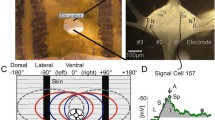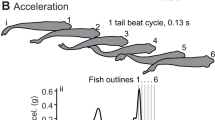Abstract
As an initial step in constructing a quantitative biomechanical model of the medicinal leech (Hirudo medicinalis), we determined the passive properties of its body wall over the physiological range of dimensions. The major results of this study were:
-
1.
The ellipsoidal cross section of resting leeches is maintained by tonic muscle activation as well as forces inherent in the structure of the body wall (i.e., residual stress).
-
2.
The forces required for longitudinal and circumferential stretch to maximum physiological dimensions were similar in magnitude. Cutting out pieces of body wall did not affect the passive longitudinal or circumferential properties of body wall away from the edges of the cut.
-
3.
The strain (i.e., the percentage change in dimension) of different body segments when subject to the same force was identical, despite differences in muscle crosssections.
-
4.
Serotonin, a known modulator of tension in leech muscles, affected passive forces at all physiological muscle lengths. This suggests that the longitudinal muscle is responsible for at least part of the passive tension of the body wall.
-
5.
We propose a simple viscoelastic model of the body wall. This model captures the dynamics of the passive responses of the leech body wall to imposed step changes in length. Using steady-state passive tensions predicted by the viscoelastic model we estimate the forces required to maintain the leech at any given length over the physiological range.
Similar content being viewed by others
References
Baader AP, Kristan WB Jr (1992) Monitoring neuronal activity during discrete behaviors: A crawling, swimming and shortening device for tethered leeches. J Neurosci Meth 43: 3215–3223
Bowtell G, Williams TL (1994) Anguilliform body dynamics: a continuum model for the interaction between muscle activation and body curvature. J Math Biol 32: 83–91
Brodfuehrer PD, Friesen WO (1986) From stimulation to undulation: an identified pathway for the control of swimming activity in the leech. Science 234: 1002–1004
Chapman G (1950) Of the movement of worms. J Exp Biol 27: 29–39
Chapman G (1975) Versatility of hydraulic systems. J Exp Zool 194: 249–270
Chapple WD (1989) Mechanics of stretch in activated crustacean slow muscle II: Dynamic changes in force in response to stretch. J Neurophysiol 62: 1006–1017
Chiel HJ, Crago P, Mansour JM, Hathi K (1992) Biomechanics of a muscular hydrostat: a model of lapping by a reptilian tongue. Biol Cybern 67: 403–415
Cruse H (1990) What mechanisms coordinate leg movement in walking arthropods? Trends Neurosci. 13(1): 15–21
Ekeberg O (1993) A combined neuronal and mechanical model of fish swimming. Biol Cybern 96: 363–374
Friesen WO (1989) Neuronal control of leech swim movements. In: Jacklet JW (ed) Neuronal and cellular oscillators Dekkar, New York, pp 269–316
Fung YC (1991) What are the residual stresses doing in our blood vessels? Ann Biomed Eng 19: 237–249
Fung YC (1993) Biomechanics: mechanical properties of living tissues. 2nd Edition. Springer New York
Galbraith JA, Thibault LE, Matteson DR (1993) Mechanical and electrical responses of the squid giant axon to simple elongation. J Biomech Eng 115: 13–22
Gascoigne L, McVean A (1991) Neuromodulatory effects of acetylcholine and serotonin on the sensitivity of leech mechanoreceptors. Comp Biochem Physiol C: Comp Pharmacol 99: 369–374
Glantz SA (1974) A constitutive equation for the passive properties of muscle. J Biomechanics 7: 137–145
Hess F, Videler JJ (1993) Fast continuous swimming of saithe (Pollachius virens): a dynamic analysis of bending moments and muscle power. J Exp Biol 109: 229–251
Kier WM, Smith KK (1985) Tongues, tentacles and trunks: the biomechanics of movement in muscular hydrostats. Zool J Linn Soc 83: 307–324
Kristan WB Jr, Wittenberg G, Nusbaum MP, Stern-Tomlinson W (1988) Multifunctional interneurons in behavioral circuits of medicinal leech. Experientia 44: 383–389
Lanzavecchia G, DeEguileor M, Valvassori R (1985) Superelongation in helical muscles of leeches. J Musc Res Cell Motil 6: 569–584
Leake LD (1986) Leech Retzius cells and 5-Hydoxytryptamine. Comp Biochem Physiol 83: 229–239
Linton M, Gallo PS (1975) The practical statistician: simplified handbook of statistics. Brooks/Cole Publishing Company, Monterey, pp 166–174
Lockery SR, Kristan WB Jr (1990) Distributed processing of sensory information in the leech. I. Input-output relations of the local bending reflex. J Neurosci 10: 1811–1815
Lutz GJ, Rome LC (1994) Built for jumping: The design of the frog muscular system. Science 263: 370–372
Mann KH (1962) Leeches (Hirudinea): their structure, physiology, ecology & embryology. Pergamon Press, London
Mason A, Kristan WB Jr (1982) Neuronal excitation and modulation of leech longitudinal muscle. J Comp Physiol 146: 527–536
Mason A, Sunderland AJ, Leake LD (1979) Effect of leech Retzius cells on body wall muscles. Comp Biochem Physiol [C] 63: 359–361
McGeer T (1993) Dynamics and control of bipedal locomotion J Theor Biol 163: 277–314
Miller JB (1975) The length-tension relationship of the dorsal longitudinal muscle of a leech. J Exp Biol 62: 43–53
Miller JB, Aidley DJ (1973) Two rates of relaxation in the dorsal longitudinal muscle of a leech. J Exp Biol 58: 91–103
Norris BJ, Calabrese RL (1990) Action of FMRFamide on longitudinal muscle of the leech, Hirudo medicinalis. J Comp Physiol A 167: 211–224
Ort CA, Kristan WB Jr, Stent GS (1974) Neuronal control of swimming in the medicinal leech. II. Identification and connections of motor neurons. J Comp Physiol 94: 121–154
Rembold CM (1992) Resistance to stretch, [Ca2+]1, and activation of swine arterial smooth muscle. J Musc Res Cell Mot 13: 27–34
Rodriguez EK, Omens JH, Waldman LK and McCulloch AD (1993) Effect of residual stress on transmural sacromere length distributions in rat left ventricle. Am. J Physiol 264: H1048–56
Rome LC, Swank D and Corda D (1993) How fish power swimming. Nature 261: 340–343
Sawada M, Coggeshall RE (1976) Ionic mechanism of 5-Hydroxyrtyptamine induced hyperpolarisation and inhibitory junctional potential in the body wall muscle cells of Hirudo medicinalis. J Neurobiol 7: 63–73
Shaw BK, Kristan WB Jr (1995) The whole-body shortening reflex of the leech: motor neuron pattern, sensory basis, and interneuronal pathways. J Comp Physiol A 177: 667–681
Stuart AE (1970) Physiological and morphological properties of motoneurones in the central nervous system of the leech. J Physiol 209: 627–646
Taga G, Yamaguchi Y, Shimizu H (1991) Self-organized control of bipedal locomotion by neural oscillators in unpredictable environment. Biol Cybern 65(3): 147–159
Trueman ER, Brown AC (1976) Locomotion, pedal retraction and extension, and the hydraulic systems of Bulla J Zool Lond 178: 365–384
Wadepuhl M, Beyn W-J (1989) Computer simulation of the hydrostatic skeleton: the physical equivalent, mathematics and application to worm-like forms. J Theor Biol 136: 379–402
Walker RJ, Woodruff GN, Kerkut GA (1968) The effect of acetylcholine and 5-hydroxytryptamine on electrophysiological recordings from the muscle fibres of the medicinal leech Hirudo medicinalis. Comp Biochem Physiol 24: 987–990
Wang K, McCarter R, Wright J, Beverly J, Ramirez-Mitchell R (1993) Viscoelasticity of the sacromere matrix of skeletal muscles. J Biophys 64: 1161–1177
Weeks JC, Kristan WB Jr (1978) Initiation, maintenance and modulation of swimming in the medicinal leech by the activity of a single neurone. J Exp Biol 77: 71–88
Wilson RJA, Skierczynski BA, Meyer JK, Blackwood S, Skalak R, Kristan WB Jr. (1994) Mapping motor neuron activity to overt behaviour in the leech: A biomechanical model of the leech hydroskeleton. Soc Neurosci Abstr 20: 1598
Winter DA, MacKinnon CD, Ruder GK, Wieman C (1993) An integrated EMG/biomechanical model of upper body balance and posture during human gait. Prog Brain Res 97: 359–367
Wittenberg G, Kristan WB Jr (1992) Analysis and modeling of the multisegmental coordination of shortening behavior in the medicinal leech. I. Motor output pattern. J Neurophysiol 68: 1683–1692
Xie JP, Liu SQ, Yang RF, Fung YC (1991) The zero-stress state of rat veins and vena cava. J Biomech Eng 113: 36–41
Author information
Authors and Affiliations
Rights and permissions
About this article
Cite this article
Wilson, R.J.A., Skierczynski, B.A., Meyer, J.K. et al. Mapping motor neuron activity to overt behavior in the leech. J Comp Physiol A 178, 637–654 (1996). https://doi.org/10.1007/BF00227377
Accepted:
Issue Date:
DOI: https://doi.org/10.1007/BF00227377




